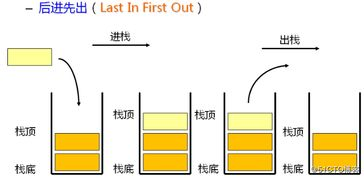前言
栈和队列是两种常用的数据结构,因此,了解他们的概念、结构和实现方法是十分基础且必要的。
一、栈
1.栈的概念及结构
栈
:一种特殊的线性表,其只允许在固定的一端进行插入和删除元素操作。进行数据插入和删除操作的一端称为栈顶,另一端称为栈底。栈中的数据元素遵守后进先出LIFO(Last In First Out)的原则。
压栈
:栈的压入操作叫做进栈/压栈/入栈,如数据在栈顶。
出栈
:栈的删除操作叫做出栈,出数据也在栈顶。

1.栈的实现
数组和链表都可以用来实现栈,一般来说用数组实现更优、因为数组尾插的代价较小。
实现思路
:建立一个结构体Stack、结构体成员包括存储栈元素的数组a、栈顶top、和栈容量capacity,通过栈顶值控制入栈(top++)出栈(top–)、判空(top==0)等操作、当栈顶与容量相等时,实现自动扩容(cap*=2 + realloc)。具体过程见代码:
头文件
***Stack.h***
#pragma once
#include<stdio.h>
#include<malloc.h>
#include<assert.h>
//#define N 10
//struct Stack {
// int a[N];
// int top;
//};
typedef int STDataType;
typedef struct Stack {
STDataType *a;
int top; //栈顶
int capacity; //容量
}Stack;
//后进先出
void StackInit(Stack *pst);//栈的初始化
void StackDestory(Stack *pst);//栈的销毁
void StackPush(Stack* pst, STDataType x);//压栈
void StackPop(Stack* pst);//出栈
int StackSize(Stack* pst);//获取栈内有效元素的个数
STDataType StackTop(Stack* pst);//获取栈顶元素
//返回1 为空,非空返回0
int StackEmpty(Stack* pst);//判断栈是否为空
主体部分
***Stack.c***
#include "Stack.h"
//后进先出
void StackInit(Stack *pst)
{
assert (pst);
//开辟大小自选
pst->a = malloc(sizeof(STDataType) * 4);
pst->top = 0;
pst->capacity = 4;
}
void StackDestory(Stack *pst)
{
assert(pst);
free(pst->a);
pst->a = NULL;
pst->top = pst->capacity = 0;
}
void StackPush(Stack* pst, STDataType x)
{
assert(pst);
if (pst->top == pst->capacity)
{
//pst->a = realloc(pst->a,sizeof(STDataType)*2*pst->capacity);
STDataType *tmp = realloc(pst->a, sizeof(STDataType) * 2 * pst->capacity);
if (tmp == NULL)
{
printf("realloc fail\n");
exit(-1);
}
pst->a = tmp;
pst->capacity *= 2;
}
pst->a[pst->top] = x;
pst->top++;
}
void StackPop(Stack* pst)
{
assert(pst);
//为空报错
assert(!StackEmpty(pst));
pst->top--;
}
int StackSize(Stack* pst)
{
assert(pst);
return pst->top;
}
STDataType StackTop(Stack* pst)
{
assert(pst);
assert(!StackEmpty(pst));
return pst->a[pst->top-1];
}
//返回1 为空,非空返回0
int StackEmpty(Stack* pst)
{
assert(pst);
return pst->top == 0 ? 1 : 0;
}
测试文件
test.c
#include"Stack.h"
void test() {
Stack st;
StackInit(&st);
StackPush(&st,1);
StackPush(&st,2);
StackPush(&st,3);
StackPush(&st,4);
StackPush(&st,5);
while (!StackEmpty(&st))
{
printf("%d", StackTop(&st));
StackPop(&st);
}
StackDestory(&st);
}
int main() {
test();
return 0;
}
共实现七个常用接口,包括栈的初始化、栈的销毁、压栈、出栈、获取栈内有效元素的个数、获取栈顶元素、与判断栈是否为空。测试文件测试结果如下:

可以看到栈后进先出的规律。
二、队列
1.队列的概念及结构
队列
:只允许在一端进行插入数据操作,在另一端进行删除数据操作的特殊线性表,队列具有先进先出FIFO(First In First Out) 。
入队列
:进行插入操作的一端称为队尾 。
出队列
:进行删除操作的一端称为队头。

2.队列的实现
队列也可以用数组和链表实现,使用链表的结构实现更优,因为如果使用数组结构,出队列在数组头出数据,效率较低
实现思路
:创建一个结构体Queue、结构体成员包括两个链表节点front和tail,分别代表队列的队头和对尾。通过对两个成员进行操作,实现队列的入队、出队等操作。具体过程见代码:
头文件
***Queue.h***
#pragma once
#include<stdio.h>
#include<assert.h>
#include<stdlib.h>
typedef int QDataType;
typedef struct QueueNode
{
QDataType data;
struct QueueNode* next;
}QueueNode;
typedef struct Queue
{
QueueNode* front;
QueueNode* tail;
}Queue;
void QueueInit(Queue* pq);//队列初始化
void QueueDestory(Queue* pq);//销毁队列
void QueuePush(Queue* pq, QDataType x);//入队
void QueuePop(Queue* pq);//出队
QDataType QueueFront(Queue* pq);//获取队列头部元素
QDataType QueueBack(Queue* pq);//获取队列尾部元素
int QueueSize(Queue* pq);//获取队列有效元素个数
int QueueEmpty(Queue* pq);//队列判空
主体
***Queue.c***
#include"Queue.h"
void QueueInit(Queue* pq)
{
assert(pq);
pq->front = pq->tail = NULL;
}
void QueuePush(Queue* pq, QDataType x)
{
assert(pq);
QueueNode* newnode = (QueueNode*)malloc(sizeof(QueueNode));
newnode->data = x;
newnode->next = NULL;
if (pq->tail == NULL)
{
pq->front = pq->tail = newnode;
}
else
{
pq->tail->next = newnode;
pq->tail = newnode;
}
}
void QueuePop(Queue* pq)
{
assert(pq);
assert(!QueueEmpty(pq));
if (pq->front == pq->tail)
{
free(pq->front);
pq->front = pq->tail = NULL;
}
else
{
QueueNode* next = pq->front->next;
free(pq->front);
pq->front = next;
}
}
int QueueSize(Queue* pq)
{
assert(pq);
int size = 0;
QueueNode* cur = pq->front;
while (cur)
{
++size;
cur = cur->next;
}
return size;
}
QDataType QueueFront(Queue* pq)
{
assert(pq);
assert(!QueueEmpty(pq));
return pq->front->data;
}
QDataType QueueBack(Queue* pq)
{
assert(pq);
assert(!QueueEmpty(pq));
return pq->tail->data;
}
int QueueEmpty(Queue* pq)
{
assert(pq);
return pq->front == NULL ? 1 : 0;
}
void QueueDestory(Queue* pq)
{
assert(pq);
QueueNode* cur = pq->front;
while (cur)
{
QueueNode* next = cur->next;
free(cur);
cur = next;
}
pq->front = pq->tail = NULL;
}
测试部分
***test.c***
#include"Queue.h"
void test()
{
Queue q;
QueueInit(&q);
QueuePush(&q, 1);
QueuePush(&q, 2);
QueuePush(&q, 3);
QueuePush(&q, 4);
while (!QueueEmpty(&q))
{
int front = QueueFront(&q);
printf("%d", front);
QueuePop(&q);
}
printf("\n");
QueueDestory(&q);
}
int main()
{
test();
return 0;
}
实现七个接口,包括队列初始化、销毁队列、入队、出队、获取队列头部元素、获取队列尾部元素、获取队列有效元素个数和队列判空。
测试代码结果如下:

可以观察到其先进先出的特性。